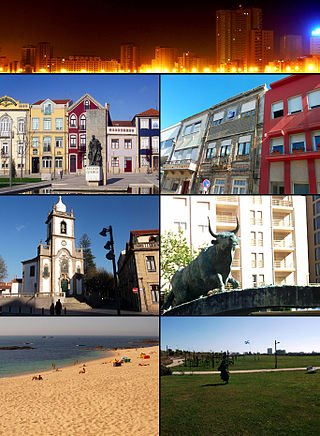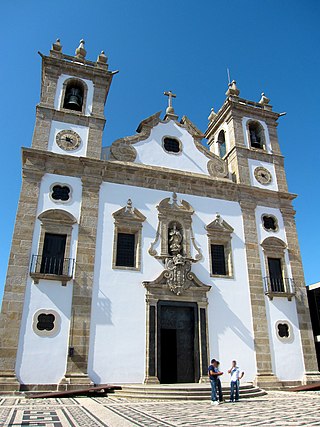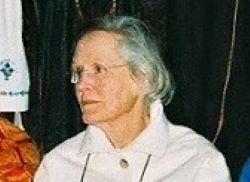
Póvoa de Varzim is a Portuguese city in Northern Portugal and sub-region of Greater Porto, 30 km (18.6 mi) from its city centre. It sits in a sandy coastal plain, a cuspate foreland, halfway between the Minho and Douro rivers. In 2001, there were 63,470 inhabitants, with 42,396 living in the city proper. The city expanded southwards, to Vila do Conde, and there are about 100,000 inhabitants in the urban area alone. It is the seventh-largest urban agglomeration in Portugal and the third largest in Northern Portugal.

Vila do Conde is a municipality in the Norte Region of Portugal. The population in 2011 was 79,533, in an area of 149.03 km². The urbanized area of Vila do Conde, which includes the parishes of Vila do Conde, Azurara and Árvore, represent 36,137 inhabitants. Vila do Conde is interlinked to the north with Póvoa de Varzim, forming a single urban agglomeration which is a part of the Porto Metropolitan Area. The town is on the Portuguese Way of the Camino de Santiago.

Vila Nova de Famalicão is a Portuguese town with a population of approximately 133,048 inhabitants in an area of 201,59 km2, subdivided into 49 parishes. Inserted in the Braga District, in the North Region of Portugal and in the Sub-Region of Vale do Ave, global positioned at 41⁰24’36” N | 8⁰31’13.53” W. The population of Vila Nova was created in 1205 with the charter given by the King Sancho I. The municipality was created in 1835 as a detachment from Barcelos and was elevated to the category of “Vila” with the charter given by the Queen D. Maria II. In 1985, approved by National Assembly, Vila Nova de Famalicão was elevated to the category of "city". The inhabitants of Famalicão are called Famalicenses.

The Porto Metropolitan Area is a metropolitan area in northern Portugal centered on the City of Porto, Portugal's second largest city. The metropolitan area, covering 17 municipalities, is the second largest urban area in the country and one of the largest in the European Union, with a population in 2021 of 1,737,395 in an area of 2,040.31 km².

The Porto Metro, part of the public transport system of Porto, Portugal, is a light rail network that runs underground in central Porto and above ground into the city's suburbs. Metro do Porto S.A. was founded in 1993, and the first line of the system opened in 2002.

Albuquerque Mendes is a Portuguese artist. He works in the fields of painting, performance art and installation.

The Residence of Águas Férreas is a residence in the civil parish of Cedofeita, Santo Ildefonso, Sé, Miragaia, São Nicolau e Vitória, in the municipality of Porto, in the Portuguese district of Porto.

The architecture of Póvoa de Varzim, in Portugal, demonstrates a broad variety of architectural styles over its thousand years of history. 11th-century Romanesque, 16th-century Mannerism, 18th-century Baroque, late 18th-century neoclassicism, early 20th-century Portuguese modernism and late 20th- to early 21st-century contemporary architectural styles and more are all represented in Póvoa de Varzim. As a whole it represents a rich eclectic tradition and innovation shaped by the people, their beliefs and economy.

The Porto Customshouse Congress Centre is a convention centre and former-customshouse situated in the civil parish in Cedofeita, Santo Ildefonso, Sé, Miragaia, São Nicolau e Vitória, in the northern Portuguese municipality of Porto. The building is located in the historic centre of the city, along the bank of the Douro River, and was renovated under the direction of the Pritzker-awarded architect Eduardo Souto de Moura. It is part of the Museum of Transport and Communication, founded on 21 February 1992, as a non-profit institution comprising 56 individual associates and 25 institutional associates.

Jeannette Nolen was a Dutch archaeologist who carried out extensive research in Portugal.

Graça MoraisGOIH is a Portuguese artist. A member of the Academia Nacional de Belas-Artes of Portugal, she was made a Grand Officer of the Order of Prince Henry in 1997. She is married to the musician Pedro Caldeira Cabral.
This page is based on this
Wikipedia article Text is available under the
CC BY-SA 4.0 license; additional terms may apply.
Images, videos and audio are available under their respective licenses.










